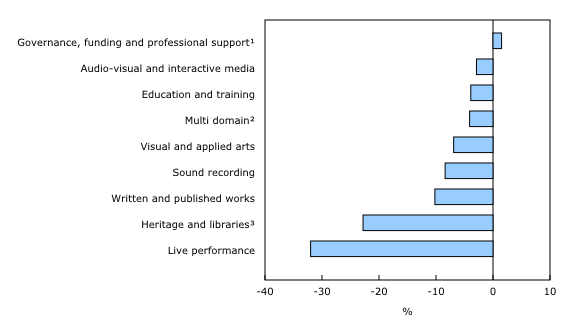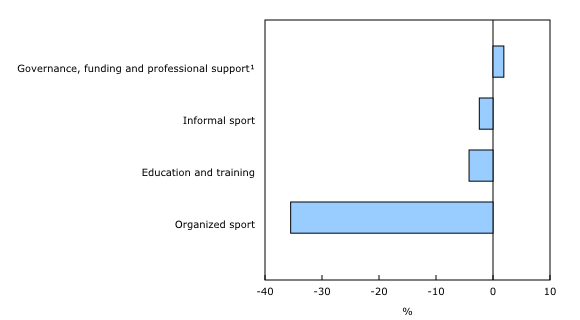Provincial and Territorial Cultural Indicators, 2020
Released: 2022-06-02
Culture and sport play a vital role in the economic and socioeconomic well-being of Canadians from coast to coast to coast. Whether it be taking in an exhibit at your local museum, attending a Major League Baseball game or seeing your favourite band in concert, all of these things were abruptly halted when the COVID-19 pandemic hit in early 2020.
The economic activities of culture and sport were directly impacted by COVID-19 restrictions, as they faced unprecedented disruptions. In 2020, nominal gross domestic product (GDP) of culture and sport fell in nearly all provinces and territories. Canada's GDP attributable to culture and sport contracted 6.7%, to $60.9 billion, decelerating quicker than the total economy (-4.0%). This marked the sharpest annual decline in GDP attributable to culture and sport since 2010, when the series began. The contribution of culture and sport to economy-wide GDP declined slightly from 3.0% in 2019 to 2.9% in 2020.
In 2020, employment attributable to Canada's culture and sport sector contracted 11.4%, translating into a loss of 87,757 jobs, while economy-wide jobs were down 9.4%.This contributed to a decline in culture and sport's share of jobs, which edged down from 4.0% in 2019 to 3.9% in 2020.
Culture sector among the hardest hit by COVID-19 related closures and restrictions
The nominal GDP for Canada's culture sector decreased 6.0% to $55.5 billion in 2020. The largest contributors to this decline were the live performance (-$972.2 million or -32.0%) and heritage and libraries (-$180.3 million or -22.8%) domains. Offsetting those decreases was an increase in the culture governance, funding and professional support domain (+$125.3 million or +1.5%), as government spending increased. For instance, governmental programs such as the Emergency Support Fund for Cultural, Heritage and Sport Organizations were administered in an effort to help the culture and sport sectors manage the challenges and impact of COVID-19. At a sub-domain level, increases in the interactive media subdomain (+6.7%) helped to soften declines in the audio-visual and interactive media domain (-2.9%), with growth tied to software publishing and computer system designs.
As a proportion of total economy GDP, culture accounted for 2.7% in 2020, virtually unchanged from 2019.
Meanwhile, culture jobs fell 10.6% to 600,553 in 2020. Economy-wide jobs decreased 9.4%. The share of culture jobs accounted for 3.4% of all jobs in Canada.
Combined, the heritage and libraries and live performance domains saw a decrease of over 22,000 jobs, accounting for close to one-third of total culture job losses.
Sizeable declines in Canada's sport sector
Sport GDP was down 13.0% in 2020, totalling $5.3 billion, with all subdomains declining, except for sport governance. Organized sport was the largest hit subdomain, with GDP contracting more than one-third (-35.5%).
Professional sports teams were particularly hard hit by the impacts of COVID-19 measures in 2020. For instance, at the onset of the pandemic, the National Hockey League and the National Basketball Association were forced to shorten their seasons and delay their playoffs, and at times, played in empty arenas, all of which negatively impacted revenues.
Parallel to sport GDP, sport employment decreased in all subdomains in 2020, decelerating at a quicker pace than culture employment. For the sport sector as a whole, jobs decreased 17.2% to 80,586.
Impact of COVID-19 on culture and sport across Canada
The scope, duration, and impact of mandatory shutdowns and COVID-19-related restrictions varied across the country, with most regions seeing sharp declines in culture GDP. Canada's three largest provinces—Ontario (-$1.5 billion or -5.4%), Quebec (-$866 million or -7.2%) and British Columbia (-$392 million or -4.7%)—witnessed some of the highest dollar value losses in GDP. The contribution of the culture sector to economy-wide GDP varied across Canada, ranging from 1.2% in Saskatchewan to 3.3% in Ontario.
Turning to employment, all provinces and territories posted job losses. Despite these losses, the contribution of culture jobs as a share of the total economy ranged from 1.7% in Nunavut to 4.2% in British Columbia.
All provinces and the Yukon experienced declines in sport GDP, with Ontario (-$370 million or -14.4%), Alberta (-$172 million or -20.7%) and Quebec (-$107 million or -12.6%) among the hardest hit. As a share of sport GDP to total economy-wide GDP, there was not much variation across Canada. In regards to jobs, losses in employment attributable to sport were seen in all provinces and territories.
Note to readers
The Provincial and Territorial Culture Indicators (PTCI) were developed as an extension of the more comprehensive Provincial and Territorial Culture Satellite Account. The PTCI cover culture (including arts and heritage) and sport across Canada in terms of output, nominal gross domestic product (GDP), and jobs for the period from 2010 to 2020.
The PTCI are a joint initiative of Statistics Canada, other federal agencies, all provincial and territorial governments, as well as non-governmental organizations.
All the GDP figures in this release are expressed in nominal, basic prices. Total economy GDP is calculated using income-based GDP at market prices minus taxes less subsidies on products and imports.
This release focuses on the product perspective of the PTCI—the production of culture and sport goods and services and their contribution to output, GDP and jobs in both culture and non-culture industries and sport and non-sport industries.
Culture GDP is the economic value added associated with culture activities. This is the value added related to the production of culture goods and services across the economy, regardless of the producing industry. Culture jobs are the number of jobs that are related to the production of culture goods and services.
Sport GDP is the economic value added associated with sport activities. This is the value added related to the production of sport goods and services across the economy regardless of the producing industry. Sport jobs are the number of jobs that are related to the production of sport goods and services.
Film and video
The film and video subdomain underwent major enhancements starting with reference year 2015. The sources and methods for estimating this subdomain, notably the Survey of Service Industries: Film, Television and Video Production, have been revised to include improved estimation methods.
The new methodology increases the use of administrative data in combination with survey data to build the estimates. These methodological improvements were applied to all variables (GDP, output and jobs). As a result, the estimates for the film and video subdomain for 2015 going forward should not be compared with estimates for earlier periods.
Users should exercise caution with any aggregates that include the film and video subdomain, such as the audio-visual and interactive media domain and the total aggregate for culture. These aggregates also reflect the methodological improvements, and, depending on the economic importance of the film and video subdomain, could be significantly affected.
Written and published works
Print publishing has continued to decline as industries shift toward producing online content. This decline can be seen within the written and published works domain with the exception of the 2017 reference year. In 2017, the sources and methods for estimating this domain were enhanced to more accurately represent the presence of online publishers. This was a result of the new 2017 North American Industry Classification System.
Products
The Economic accounts statistics portal, accessible from the Subjects module of our website, features an up-to-date portrait of national and provincial economies and their structure.
The Latest Developments in the Canadian Economic Accounts (13-605-X) is available.
The User Guide: Canadian System of Macroeconomic Accounts (13-606-G) is available.
The Methodological Guide: Canadian System of Macroeconomic Accounts (13-607-X) is available.
Contact information
For more information, or to enquire about the concepts, methods or data quality of this release, contact us (toll-free 1-800-263-1136; 514-283-8300; infostats@statcan.gc.ca) or Media Relations (statcan.mediahotline-ligneinfomedias.statcan@statcan.gc.ca).
- Date modified:


